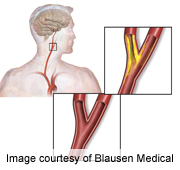
THURSDAY, Oct. 24 (HealthDay News) — For patients being treated for a blockage in the artery that supplies blood to the head, inserting a stent may raise the risk of stroke more in elderly patients than in younger patients, a large new evidence review finds.
However, death risk was similar for older and younger patients receiving stents. And it was not as high as it was for older patients who underwent a different surgical procedure — called endarterectomy — to unblock the clogged artery.
The report was published Oct. 23 in the online edition of JAMA Surgery.
An ongoing debate exists about the best treatment for the condition known as carotid artery atherosclerosis. The issue is whether placing a tiny mesh tube (a stent) to keep the plaque-clogged neck artery open is safer for older patients than endarterectomy — a surgical procedure to open the artery and remove the plaque.
For the new study, a research team led by Dr. George Antoniou, of the Hellenic Red Cross Hospital in Athens, Greece, reviewed 44 studies that looked at opening the carotid arteries with a carotid endarterectomy or by placing a stent.
These studies included more than 500,000 patients who had a carotid endarterectomy and about 75,000 patients who had a stent placed. In this type of study, called a meta-analysis, researchers try to find common patterns in a number of diverse, but similar studies.
Despite the large number of people included in these studies, Antoniou’s group found the quality of the studies was poor — with each using different criteria in classifying older and younger patients.
The researchers, however, concluded that carotid endarterectomy had similar outcomes in terms of stroke among older and younger patients, but was more often fatal among older patients.
In addition, both procedures seemed to increase the risk of heart attack in older patients. Older patients who had a stent placed, however, had a greater risk of stroke than younger patients, the investigators found.
Two experts compared the findings from the new review with those of a previous, landmark study.
“This study complements and confirms the data from the Carotid Revascularization Endarterectomy Versus Stenting Trial [CREST] that suggests that endarterectomy has a lower stroke risk than stenting in older patients,” said Dr. Ralph Sacco, chairman of neurology at the University of Miami Miller School of Medicine. He had no part in the study.
The CREST study was published in October 2010 in the journal Stroke. Although the number of deaths was slightly greater in the elderly for endarterectomy in CREST, the absolute risk of dying was not that different and actually less than with stenting for both older and younger age groups, Sacco said.
“For patients under age 70, both procedures are effective in reducing the risk of recurrent stroke due to carotid narrowing after a minor stroke,” Sacco said. “For patients over age 70, endarterectomy may have the advantage as of now, but better stents and future devices could change the picture.”
Another expert said the latest findings don’t really break new ground.
Dr. Richard Libman, vice chair of neurology at the Long Island Jewish Medical Center in New Hyde Park, N.Y., said the “extensive review of the literature does not add significantly to what has been found and what has been practiced, based on the largest and most rigorous clinical trial, which compared carotid endarterectomy to carotid stenting.”
While both procedures have their advantages and disadvantages, endarterectomy could still be considered the “gold standard” treatment but stenting is a very close second, he said.
“In addition, there are certain patients in whom endarterectomy has intrinsically high risk, such as those with severe heart or lung disease, or those who have had previous radiation to the neck, a carotid artery which had previously undergone surgery or complete occlusion of the carotid artery on the other side of the neck,” Libman said.
These high-risk patients have been studied in another clinical trial, and have been found to have fewer complications with stenting than with endarterectomy, he said. “The picture, therefore, is not clear-cut and the decision for management in every case of carotid artery narrowing needs to be individualized,” Libman said.
More information
To learn more about carotid artery stenting, visit the U.S. National Library of Medicine.
Copyright © 2025 HealthDay. All rights reserved.

